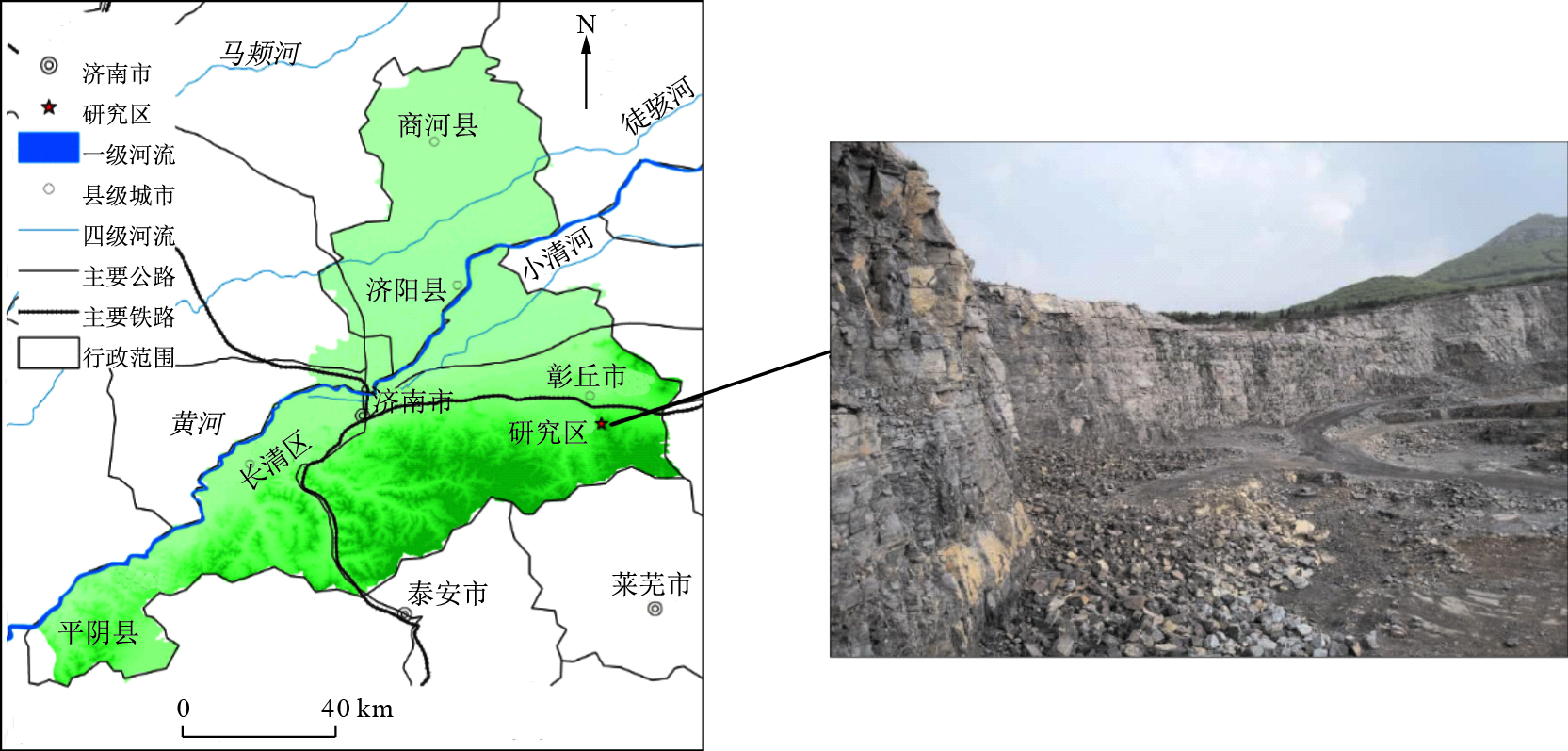Water vapor transport mechanism in unsaturated zone of rock slope and its ecological significance
-
摘要: 岩质边坡非饱和带水分对于边坡植物生长具有重要的生态学意义。目前对岩质边坡非饱和带水汽运移的系统性研究还很少,现有研究大部分集中在大气与岩体的接触面和凝结水能否生成的定性层面,而未将边坡非饱和带作为一个系统整体来研究。为了阐明岩质边坡非饱和带的水汽运移机制及其与边坡植物生长之间的关系,运用热力学和系统科学的理论,开展边坡温湿度监测试验,进行了详细的水汽运移机制的研究。研究发现,岩质边坡非饱和带内的水汽运移驱动力为水汽分压梯度,水汽从水汽分压大的位置向水汽分压小的位置运移。冬季时,水汽从边坡深部向浅部运移,夏季时,水汽从大气向边坡深部运移。岩质边坡非饱和带内存在水汽饱和带,夏季范围较大,冬季范围收缩。同时,通过对岩质边坡复绿植物的成活率进行监测分析,论述了岩质边坡非饱和带内的水汽内循环机制及其生态学意义。本文对于研究岩体非饱和带水文学、探索植物水分来源、指导岩质边坡复绿乃至干旱半干旱带的生态修复都有极为重要的理论和现实意义。Abstract: Water in unsaturated zone of rock slope has important ecological significance for plant growth.At present, there are few systematic studies on water vapor transport in unsaturated zone of rock slope.Most of studies focus on the interface between atmosphere and rock mass and the qualitative level of whether condensate water can be generated, while the unsaturated zone of rock slope is not studied as a whole system.In order to elucidate the water vapor transport mechanism in unsaturated zone of rock slope and its relationship with plant growth, this paper carries out temperature and humidity monitoring test of the slope by means of thermodynamics and system science theory, and studies the water vapor transport mechanism in detail.It is found that the driving force of water vapor migration in the unsaturated zone of rock slope is the partial pressure gradient of water vapor.In winter, water vapor migrates from deep to shallow part of the slope; in summer, water vapor migrates from atmosphere to deep part of the slope.The unsaturated zone of rock slope has water vapor saturation zone, which is larger in summer and smaller in winter.At the same time, through monitoring and analyzing the survival rate of compound green plants in rock slope, the mechanism of water vapor circulation in unsaturated zone of rock slope and its ecological significance were discussed.This paper is of great theoretical and practical significance for studying hydrology of rock mass unsaturated zone, exploring the source of plant water, guiding the rehabilitation of rock slope and even arid and semi-arid zone.
-
表 1 植物成活率统计
Table 1. Statistics of plants survival rate
物种 拉丁学名 数量/棵 成活率/% 黄栌 Cotinuscoggygria Scop. 577 91.3 连翘 Forsythiasuspensa 193 77.6 爬山虎 Parthenocissus tricuspidata 20 95.0 凌霄 Campsis grandiflora (Thunb.) Schum. 17 80.6 紫藤 Wisteriasinensis (Sims)Sweet 18 82.3 侧柏 Platycladus orientalis (L.) Franco 20 95.0 小叶扶芳藤 Euonymusfortunei var.radicans 20 75.0 腊梅 Chimonanthus praecox (Linn.) Link 10 80.0 紫丁香 Syringa oblata Lindl. 15 86.7 白皮松 Pinusbungeana Zucc.ex Endl. 15 73.3 刺槐 Robinia pseudoacacia Linn. 10 80.0 黑松 Pinusthunbergii Parl. 10 60.0 金银花 Lonicera japonicaThunb. 8 87.5 石榴 Punica granatum L. 8 100 山杏 Armeniaca sibirica (L.) Lam. 8 75 表 2 植物生长状况统计
Table 2. Statistics of plants growth status
物种 数量/棵 基径 高度(长度) 冠幅 值/mm 年增长率/% 值/cm 年增长率/% 值/cm 年增长率/% 黄栌 49 13.70 40.52 67.40 44.36 55.20 184.79 连翘 41 6.60 4.46 43.10 6.86 30.40 18.11 爬山虎 7 5.60 53.16 53.33 220.51 40.23 85.32 凌霄 7 6.84 13.33 32.75 14.04 26.54 36.54 紫藤 5 13.00 23.86 57.33 21.31 34.21 15.62 侧柏 11 11.79 34.21 63.90 41.52 27.10 42.58 扶芳藤 6 4.60 26.67 54.70 127.24 40.12 75.32 腊梅 4 7.75 23.11 39.00 19.64 30.00 60.00 丁香 5 11.80 15.56 75.00 75.00 49.00 86.11 白皮松 3 9.20 4.76 25.00 3.57 12.00 2.97 刺槐 4 19.00 96.15 96.00 132.86 112.00 329.66 黑松 5 7.75 2.72 57.3 5.32 24.87 2.15 金银花 2 7.10 21.00 23.00 65.00 40.00 50.00 -
[1] 刘中亮, 郝岩松, 万福绪.我国石质困难地植被恢复与重建[J].南京林业大学学报:自然科学版, 2010, 34(2):137-141. http://d.old.wanfangdata.com.cn/Periodical/njlydxxb201002031 [2] 朱凯华, 尹金珠, 许小娟, 等.石油储备库等特殊建设项目区的生境特点及生态治理对策[J].水土保持通报, 2012, 32(6):177-181. http://www.wanfangdata.com.cn/details/detail.do?_type=perio&id=stbctb201206039 [3] 孙自永, 余绍文, 周爱国, 等.新疆罗布泊地区凝结水试验[J].地质科技情报, 2008, 27(2):91-96. doi: 10.3969/j.issn.1000-7849.2008.02.016 [4] 庄艳丽, 赵文智.凝结水对温带荒漠一年生植物生态作用研究[J].干旱区研究, 2009, 26(4):526-532. http://d.old.wanfangdata.com.cn/Periodical/ghqyj200904013 [5] Dawson T S F A.Water sources used by didymopanax pittieri at different life stages in a tropical cloud forest[J].Ecology, 1998(4):1448-1452. http://www.wanfangdata.com.cn/details/detail.do?_type=perio&id=10.1890/0012-9658(1998)079[1448:WSUBDP]2.0.CO;2 [6] Corbin J D, Thomsen M A, Dawson T E, et al.Summer water use by California coastal prairie grasses:fog, drought, and community composition.[J].Oecologia, 2005:511-521. https://www.ncbi.nlm.nih.gov/pubmed/16001220 [7] 余绍文, 孙自永, 周爱国, 等.罗布泊北部地区凝结水对地下水补给作用的模拟[J].地质科技情报, 2011, 30(6):116-121. doi: 10.3969/j.issn.1000-7849.2011.06.017 [8] 曹文炳, 万力, 周训, 等.西北地区沙丘凝结水形成机制及对生态环境影响初步探讨[J].水文地质工程地质, 2003(2):6-10. doi: 10.3969/j.issn.1000-3665.2003.02.002 [9] 贺再球.非饱和土气态水迁移规律及其与液态水混合迁移的耦合计算[D].西安: 西安建筑科技大学, 2004. [10] N竞生尔J.Bear W.多孔介质流体动力学[M].陈崇希, 译.北京: 中国建筑工业出版社, 1983: 620. [11] Jackson R D.Water vapor diffusion in relatively dry soil:I.Theoretical considerations and sorption experiments[J].Soil Science Society of America, 1964(2):172-176. doi: 10.2136/sssaj1964.03615995002800020014x [12] de Freitas C R, Schmekal A.Condensation as a microclimate process:Measurement, numerical simulation and prediction in the Glowworm Cave, New Zealand[J].International Journal of Climatology, 2003(5):557-575. https://www.researchgate.net/publication/227946561_Condensation_as_a_microclimate_process_Measurement_numerical_simulation_and_prediction_in_the_Glowworm_Cave_New_Zealand [13] Garcia-Padron R, Loyd D, Sjökvist S.Heat and moisture transfer in wet sand exposed to solar radiation:Models and experiments concerning vuried objects[J].Sensing and Imaging, 2002(2):125-150. doi: 10.1023/A:1015561715917 [14] 万力, 曹文炳, 周训, 等.包气带中温度变化对水分分布影响的实验研究[J].水文地质工程地质, 2004(3):25-28. doi: 10.3969/j.issn.1000-3665.2004.03.006 [15] Vries D A D.Simultaneous transfer of heat and moisture in porous media[J].Trans Amer Geophys Union, 1958, 39(5):909. doi: 10.1029/TR039i005p00909 [16] Zueco J, López-Ochoa L M.Network numerical simulation of coupled heat and moisture transfer in capillary porous media[J].International Communications in Heat and Mass Transfer, 2013, 44(Complete):1-6. http://www.wanfangdata.com.cn/details/detail.do?_type=perio&id=44a66fdca752cf21363c0680b773aa98 [17] 柴利杰.云冈石窟水分来源控制因素[D].北京: 中国地质大学(北京), 2011. [18] 黄继忠, 万力, 彭涛, 等.云冈石窟水分来源探查工程及若干成果[J].工程勘察, 2012, 40(11):1-5. http://d.old.wanfangdata.com.cn/Periodical/gckc201211001 [19] 陈星.云冈石窟砂岩表层温度效应及劣化机理研究[D].武汉: 中国地质大学(武汉), 2012. [20] 朱华, 杨刚亮, 方云, 等.龙门石窟潜溪寺凝结水病害形成机理及防治对策研究[J].中原文物, 2008(4):109-112. doi: 10.3969/j.issn.1003-1731.2008.04.018 [21] 万力, 曹文炳, 王旭升, 等.云冈石窟水汽转化特征的初步研究[J].工程勘察, 2012, 40(11):6-11. http://d.old.wanfangdata.com.cn/Periodical/gckc201211002 [22] 杨婷.麦积山石窟防渗防潮技术研究[D].兰州: 兰州大学, 2011. [23] 阎宏彬, 黄继忠, 赵新春, 等.温度、湿度的变化对云冈石窟保存的影响[J].山西大同大学学报:自然科学版, 2007(6):25-29. http://d.old.wanfangdata.com.cn/Periodical/sxdtdxxb200703009 [24] 张人权, 梁杏, 靳孟贵, 等.水文地质学基础[M].第6版.北京:地质出版社, 2011:199. [25] 张蔚榛.地下水与土壤水动力学[M].北京:中国水利水电出版社, 1996:441. [26] 邵明安, 王全九, 黄明斌.土壤物理学[M].北京:高等教育出版社, 2006:320. [27] 王永珍.高等工程热力学[M].北京:清华大学出版社, 2013:249. [28] 邹邦银.热力学与分子物理学[M].武汉:华中师范大学出版社, 2004. [29] 徐恒力, 孙自永, 马瑞.植物地境及物种地境稳定层[J].地球科学:中国地质大学学报, 2004, 29(2):239-246. http://d.old.wanfangdata.com.cn/Periodical/dqkx200402019 -





 下载:
下载:









